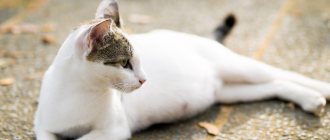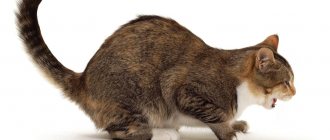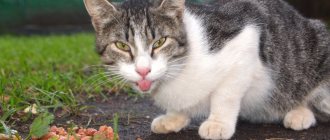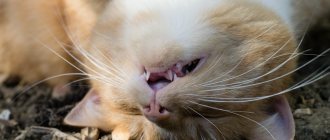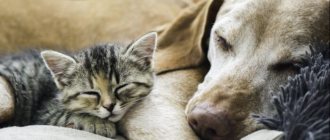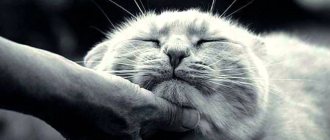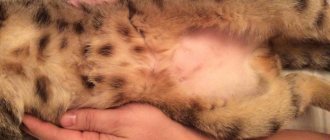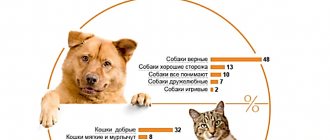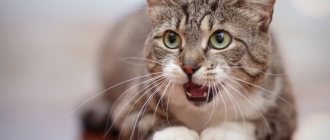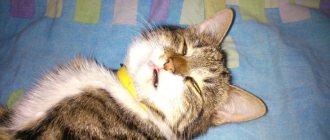Pulmonary edema in a cat
Pulmonary edema is a condition in which the level of fluid in the lungs is higher than normal.
Blood plasma leaves the vessel and fills the intercellular pulmonary space. The lungs increase in size, but can no longer fully perform their direct function. The reason for oxygen starvation during edema is that with each breath, the accumulated liquid tends to foam. From one milliliter of such liquid, about 15 milliliters of foam are obtained.
As it accumulates, it fills the airways and significantly increases the load on the respiratory muscles. The oxygen that enters the lungs simply does not reach the alveoli, mixing with foam bubbles. As a result, respiratory failure progresses.
Specifics of diseases of purebred cats
In some purebred animals, as well as their mixed breeds, edema can be caused by heart failure. If we talk about breeds, the most predisposed are Scottish Fold, Oriental and Abyssinian cats, Sphynxes, Cornish Rexes and Maine Coons.
Symptoms of pulmonary edema in cats and kittens
Video about the symptoms of pulmonary edema in cats and dogs
As for clinical symptoms and manifestations, at first there is lethargy, complete or partial loss of appetite, and decreased activity of the cat. Over time, anxiety, shortness of breath (the cat breathes through its mouth), and tachycardia appear. Lack of oxygen causes cyanosis of the mucous membranes.
More severe conditions are accompanied by wheezing, initially dry, then wet. White foam appears from the nose and mouth, sometimes mixed with blood. Coordination and heart rhythm are impaired. The outcome of respiratory failure can be a hypoxemic coma, as a result of the death of brain cells due to lack of oxygen and the death of the animal, if it does not occur earlier due to the severity of the condition.
Frequent, difficult breathing through the mouth and cyanosis (blue color of the oral mucosa) require urgent treatment at the hospital for examination by a veterinarian. Since the reason that caused this condition can threaten health and even life.
Interesting facts about cats.
Why do cats spend so much time licking their fur? For cats, licking, in addition to being a means of hygiene, is a way to maintain mental balance. Grooming calms and neutralizes incipient aggressiveness. By licking, the cat licks from the fur a certain amount of a substance containing vitamin B, which is necessary to regulate mental balance. If you deprive a cat of this opportunity, he will become nervous and may even die.
Why does a cat sometimes try to lick your face or hair? The first impression a kitten receives from its mother is care in the form of licking and washing. For him, this is an act of care and concern, so if the cat (or cat) tries to lick you, take it as an attempt to take care of you in a motherly way.
Why do cats sometimes lick and bite woolen clothes, balls, scarves? There are several theories, but scientists generally believe that the reason is the same as in the previous question.
Why are some people allergic to cat hair? Strictly speaking, the allergy is not caused by fur, but by the FEL D1 protein contained in cat saliva. When a cat washes itself and licks itself, it transfers saliva to its fur, after which it can end up on furniture and carpets. Different individuals have different amounts of protein secreted, but in general, cats are less allergenic than cats. There are two ways to prevent such an allergy - bathe the cat, rinsing the substances from the fur (which is not recommended to do often), or wipe the cat's fur with a special soft cloth.
Why does a cat, lying in your arms, move its paws, “beating” something? The reason again lies in childhood. A kitten feeding on mother's milk, massaging the cat's belly with its paws, stimulates the “supply” of milk. An adult animal uses this technique to show extreme comfort and satisfaction.
Why do cats usually
Source
The most “harmless” cause of difficult breathing may be simple overheating. If you have adequately assessed the situation and the air temperature really goes beyond normal limits (+ 30*C and above), then first aid should consist of cooling the animal and providing complete rest and fresh water.
It is worth considering that dousing with cold water and ice in the drinking bowl can lead to sudden hypothermia. Stress on the cardiovascular system in extreme temperatures threatens strokes and heart attacks. It is better to wipe the cat with a damp towel and pour water at room temperature. It is better to postpone food and other drinks until the condition stabilizes. It wouldn't hurt to call the veterinarian.
Rapid breathing through the mouth after active physical activity, especially unusual for a cat, can be a sign of both overwork and hypertrophic cardiomyopathy. The disease in most cases is hereditary and early diagnosis can provide a chance for timely treatment and a positive prognosis.
The disturbances boil down to thickening of the walls of the heart muscle and, accordingly, a decrease in the volume of the left ventricle and obstructed blood flow. Secondary HCM develops as a consequence of other diseases: hypertension, hyperthyroidism. General weakness and shortness of breath in the absence of physical activity, symptoms that arise suddenly should alert the owners. Some breeds are prone to the presence of a mutational contractile protein gene - these are Maine Coons, British and Scottish Folds, Redgalls, Norwegian Forest. ECHO and ECG will help accurately diagnose the causes of abnormal breathing.
Rhinitis, as a result of colds, injuries, allergies, parasites, a foreign body leads to blockage of nasal passages with mucus.
Treatment boils down to eliminating the underlying disease and constant sanitation of the wings
The main causes of deterioration in breathing in a cat
Veterinarians identify a number of symptoms that, together with a protruding tongue, indicate various diseases:
- difficulty breathing;
- the cat is lethargic and does not play;
- the pet becomes aggressive;
- the oral mucosa is red, and sometimes a bluish tint appears;
- dry mucous membrane;
- lack of appetite;
- wounds, mouth ulcers.
If your cat develops the above symptoms, you need to immediately take him to the clinic for examination.
Signs that your cat needs emergency help:
- frequent difficulty breathing with an open mouth or sticking out tongue, like a dog, abdominal inhalation;
- sounds uncharacteristic for a pet (wheezing);
- unusual unnatural pose;
- the pet is lying down and cannot get up;
- anxiety, fear, aggressiveness, lethargic pet;
- pallor and blueness of the mucous membranes (gums, lips, tongue).
If these symptoms are detected, it is necessary to urgently take the cat to a veterinary clinic.
It is strictly forbidden to administer human medications or perform any procedures on your own. This group of products is completely unsuitable for use in animals and can cause irreparable harm to health.
If dangerous symptoms appear, you should immediately contact a veterinarian
Nervous system and brain
Another reason that an animal shows its tongue is dysfunction of the nervous system. They can be a temporary phenomenon when they become the result of a severe shock the cat has experienced. For example, after moving to a new house, spending a long time alone, giving birth, etc.
However, there are more serious factors. These include pinched nerve endings or disruption of brain function due to injury or pathological processes. Such conditions may be accompanied by convulsions, twitching of limbs, and squint. All this is a reason to urgently contact a specialist.
Treatment of runny nose in cats
If you notice snot in a cat, you should watch your pet. Many serious pathologies, one of the manifestations of which is a runny nose, are accompanied by other unpleasant symptoms - the owner will have to talk about them during a visit to the doctor. Only a specialist can find out the cause of rhinitis.
Traditional methods of treating a runny nose
If the animal’s behavior has not changed - it is playful and does not refuse food, then before visiting the veterinarian you can relieve a runny nose using folk methods:
inhalation with eucalyptus: an infusion of 15 g of herb and 200 ml of boiling water is used - it is prepared within 30 minutes; for inhalation, you can use a teapot; before the procedure, the pet should be wrapped in a towel and sat down so that the spout of the teapot is in close proximity to the animal’s face, and care must be taken to ensure that the pet does not get burned; applying a bag of warm sand or salt: the procedure may be accompanied by copious discharge, which must be removed with a previously prepared disc or cotton swab; rinsing with saline solution: the liquid is injected carefully using a syringe without a needle - 0.5 ml is enough for each nostril; Before starting manipulations, the animal must be wrapped in a diaper or piece of cloth
Video: treating a kitten for a runny nose with folk remedies
Treatment of a runny nose in a cat with medications
After determining the cause of a runny nose in a pet, a specialist will prescribe appropriate therapy. If a runny nose is one of the signs of an infectious disease, then you cannot do without an antibiotic. Frequently prescribed drugs in this group include Amoxiclav and Baytril. For mycoplasmosis and chlamydia, tetracycline drugs are prescribed, and for bordetellosis, Ciprofloxacin is indicated. Neotim, Vitafel, Giscan are used in the treatment of viral infections. The duration of treatment and dosage of drugs is determined by a specialist.
Drops are used to relieve congestion. Special products for animals, sold in veterinary pharmacies, not only relieve congestion, but also have an immunomodulatory effect. These include:
- Anandin - dosage - 2-3 drops in each nasal passage, up to three times a day;
- Maxidin - dosage - 1-2 drops in each nasal passage, 2-3 times a day;
Drops for cats relieve nasal congestion
You need to be careful when dripping into your cat's nose.
If the nature of nasal discharge is allergic, therapy with antihistamines will be required. The most effective and harmless anti-allergy drugs are Zyrtec and Fexofenadine.
It is better to entrust the removal of a foreign body from the nasal passage to a veterinarian. Manipulations are carried out under local anesthesia; in particularly severe cases, surgery is necessary. Surgical intervention cannot be avoided even in the presence of polyps.
Treatment of small pets is practically no different from treatment of adult animals. For furry babies, the specialist prescribes medications approved for use in kittens. To ease breathing, the following can be used: Aquamaris, children's Pinosol, Protargol, inhalations. There are no contraindications for Anandin drops either. Antibiotics acceptable for use in small pets include Vilprafen.
Symptomatic diet and procedures
If the cat is pregnant or has just taken a ride on public transport, its breathing disorder is temporary. In this case, she does not require treatment. It is enough to drop a couple of drops of valerian or motherwort, and the animal will calm down.
If the animal is wheezing and breathing through its mouth, you can try to independently examine its nasopharynx. Perhaps a foreign object got there. It should be removed. You can try to grab the animal by the hind legs and turn it upside down. In this position, the cat needs to be gently but confidently shaken 2-3 times.
It happens that a foreign object sticks to the larynx. Getting it becomes a problematic task. To do this, you need to restrain the cat, literally swaddle it and thereby immobilize it. You need to open the cat's mouth, illuminate it with a flashlight and try to remove the foreign body.
If the cat is not breathing, it is recommended to perform closed cardiac massage and perform artificial respiration. To do this, the cat is placed on its back and fixed so that the neck and spine are in line. The animal's mouth should be closed and air should be blown through the nose. To do this, the palm is rolled into a tube, placed against the nose and air is blown in at a frequency of 20 blows per minute. At the same time, external cardiac massage is performed. To carry out a massage, the animal’s chest is pinched with your hands: thumbs on the chest, the remaining fingers on the back, then squeezing and unclenching movements are made.
How can you help your pet?
In some cases, the owner himself can guess why his cat is sneezing and breathing heavily with his mouth open, and take certain actions:
- If shortness of breath appears on a hot summer day, especially when the animal is in a carrier or traveling with you in the car, then it may be a reaction to overheating. You should immediately take the cat out into the fresh air, turn on the air conditioner, cover the animal with a cool wet towel or wash it with cool water.
- If your cat has trouble breathing, sneezes, has snot running, has discharge from the eyes and has a fever, then everything points to an infectious disease - see a doctor as soon as possible! How you can help yourself in this case, we wrote in the article “What to do at home if your cat sneezes?”
- If shortness of breath occurs periodically, for example, seasonally, during flowering plants, or after active play, the cat should be examined for asthma and heart problems (a tendency to the latter is observed in some breeds, including the British and Scottish fold).
The most important thing that all pet owners should remember: if a pet suddenly develops shortness of breath, accompanied by a sharp deterioration in its condition, the cat has lost orientation or has stopped responding to external stimuli altogether, it needs urgent veterinary help! Minutes can count!
This happens both after injury and during poisoning. In an apartment, a cat may accidentally lick household chemicals or chew houseplants from the lily family - they are usually poisonous. A similar condition can occur without visible external causes, for example, with thromboembolism, damage to the heart and other internal organs.
Therefore, if a cat breathes “touchingly” with his tongue hanging out, this is not a reason for laughter, but for an immediate visit to the veterinary clinic.
Symptoms when you don't need to worry
Relaxation. When the cat is resting or sleeping, she is relaxed, and even the tongue becomes a little longer. Many people have probably often watched how touchingly the edge of the tongue of a sleeping lump sticks out.
Absent-mindedness. After bathing and active licking, the pet may simply forget to hide its “brush” back. Also, after playing actively, the tongue may remain stuck out for a while.
Heat. In the summer, when it is hot outside, cats, like people, suffer from the heat. By sticking their tongue out, they regulate body temperature. If it is very hot, you need to help your pet. In order to avoid heat stroke, it is necessary to move the animal into the shade, be sure to give it water and wet its fur. In the future, monitor his condition. Avoid excessive overheating.
Malocclusion. Some breeds, such as Persians, often have an abnormal bite as a feature. As a result, the tongue does not fit in the jaws and sticks out. This can occur after prolonged selection and genetic changes. Such animals are not allowed to participate in exhibitions and breeding. If a pet has this feature and nothing bothers him, then everything is fine and there is no need to worry.
Excitement. If a cat is stressed, for example when traveling in a car or for other reasons, then the animal is scared and therefore sticks out its tongue. As soon as the cat’s anxiety passes, her condition returns to normal.
Signs of wheezing
The cat is coughing: why it wheezes, the reasons, as if it was choking
Wheezing is understood as noisy breathing, against the background of which a combination of many wheezing and whistling sounds is heard. Such deviation from normal breathing is a frequent companion to most pathologies of the animal’s respiratory tract.
Wheezing can occur for two reasons:
- in the process of narrowing the lumen of the respiratory tract;
- due to the accumulation and foaming of fluid in the respiratory system.
Noises and wheezing when breathing do not bode well
In addition, wheezing means a hoarse, strained voice or its complete absence. This pathology occurs due to incomplete closure of the vocal cords due to the accumulation of mucus in the glottis, which is a common symptom of many inflammatory processes.
The cat is breathing heavily and wheezing
Reasons that lead to loss of voice:
- Respiratory diseases are one of the common causes of wheezing when breathing in a cat. We are talking about various viral and infectious diseases that can be picked up by hypothermia in the cold season. It could be a cold or acute respiratory infection.
- Advanced respiratory diseases can lead to the development of pneumonia, viral feline rhinotracheitis, tonsillitis, calcivirosis or bronchial asthma, a common symptom of which is also loss of voice and wheezing.
- A foreign body in the larynx mechanically damages the surface of the pharynx due to the inability to swallow or regurgitate. This ultimately leads to the cat wheezing when he breathes. A pet can injure its throat with a thin or broken chicken bone, a tree branch, or choking on a spruce needle. Such damage is dangerous due to the high probability of a foreign object entering further into the digestive tract, injuring the upper respiratory tract and esophagus.
- Heart pathology. If the cat begins to show less activity, preferring to lie down instead of playing, walks slowly towards the bowl, as if overcoming obstacles, and upon reaching the goal, chokes, coughs or sneezes, this may be a sign of the development of heart pathologies. Often, owners are not even aware of the onset of heart problems in their cats due to the absence of symptoms. The disease develops, the body reaches a critical point, and after that symptoms appear and increase exponentially. A hoarse cat suffers from severe shortness of breath even after the slightest exertion. She has cold paw pads and ears, pallor of visible mucous membranes (gums, palate, eyes) due to poor blood circulation, in severe advanced cases, audible wheezing in the cat and bubbling in the chest, cold surface of the skin throughout the body.
The cat is trying to vomit a small object stuck in its throat
- Blood pathologies with a lack of iron in the body can also cause difficulty breathing with wheezing.
- With asthma, a cat wheezes and wheezes, presses to the floor, coughs, stretching its neck. As the disease progresses, severe shortness of breath and wheezing, even suffocation, appear.
- Pulmonary edema in a cat is an abnormal accumulation of fluid in the lungs, which is a consequence of various diseases of the internal organs and inflammatory processes. In this case, the cat wheezes when breathing with gurgling. He feels lethargic, phlegmatic, and desires to constantly sleep. The pet opens its mouth slightly with its tongue hanging out when breathing, inflating its belly and sides, trying to squeeze out liquid by coughing and swallowing; when coughing up, traces of blood, a bluish tint to the oral mucosa, and mucus from the nose may appear. A common urge of a cat is to expand its chest by standing in a position with its paws spread wide apart. Deterioration of the condition forces the cat to stretch out on its side.
- The accumulation of large amounts of fluid can be not only in the lungs, but also in the abdominal cavity. This pathology is called abdominal ascites, or dropsy. The pressure of the accumulated fluid compresses the internal organs, disrupting their activity. If dropsy is not treated in time, it can lead to the death of your pet.
Asthma can cause your cat to suffocate if you don't take action.
Additional symptoms
Whatever the cause, cough and shortness of breath cannot diagnose the disease. In this case, the complex clinical picture should be considered. When collecting information about the disease, not a single symptom should be discarded.
To make a diagnosis, you should pay attention to:
- general condition (depression, lethargy, anxiety);
- food intake (reduced or the animal refuses it completely);
- drinking water (increased thirst may indicate diabetes, and choking is an additional symptom from dry mucous membranes);
- temperature indicators (an increase in general temperature may indicate inflammatory processes in the lungs and bronchi);
- nasal discharge (mucous, purulent);
- discharge from the eyes (viral rhinotracheitis, toxoplasmosis);
- diarrhea or constipation (bacterial or viral infection, toxoplasmosis, toxocariasis).
READ Caring for a British cat during heat
Wheezing when breathing
Wheezing when breathing can be dry and wet (squelching). To hear better, you need to use a stethoscope or at least put your ear to your chest.
The cause of inflammatory processes can be either hypothermia or overheating of the animal. At this moment, the body’s resistance decreases, and the virulence of microorganisms increases.
Dry wheezing indicates initial inflammatory processes in the bronchi and lungs. At this moment, the mucous membranes are dry, and their friction is expressed by wheezing, and the cough is manifested by barking sounds. After some time, exudate begins to ooze out and the wheezing becomes moist. At this time, expectoration occurs.
The cough becomes softer, in this case they call it a wet cough. The inflammatory process is always accompanied by an increase in body temperature, depression, and refusal to feed. Initially mucous discharge begins to flow from the nasal openings, and then fibrinous and purulent. The nostrils become covered with dried crusts, which make breathing even more difficult.
Difficulty breathing and wheezing can occur with viral rhinotracheitis. In this case, a whole complex of symptoms is recorded. However, all of them may not be typical, so diagnosis should be carried out by a specialist.
The owner, when he sees a cat coughing violently and showing signs of suffocation, is very often at a loss.
A cough and a tongue outstretched in a cat cannot be a diagnostic symptom, it’s just something that makes the animal feel better. This is often how cats cough during an asthmatic attack. Rapid bronchospasm makes breathing difficult, and the animal reacts by coughing. After a few minutes, the spasm gives way to relaxation and the animal calms down.
If this happens for the first time, there is no need to be afraid, but you should consult a doctor.
Shortness of breath and difficulty breathing during sleep has the same causes as all others. However, if the cat sleeps separately from the owner, then monitor how often her exacerbation becomes difficult.
While awake, the cat often licks nasal discharge with its tongue and this makes it impossible for them to dry out. During sleep, crusts block the nasal passages, and this can cause difficulty breathing.
It’s a completely different matter if the shortness of breath is so severe that the cat wakes up the whole family at night. Immediate contact to the clinic for a full examination is the best method of help.
- Cough
- Labored breathing
- Blue gums
- Fatigue
- Weight loss
- Poor appetite
- Excessive thirst or frequent urination
- Vomit
- Diarrhea
When your cat is breathing rapidly and you, not knowing what to do, are looking for advice on this topic on the Internet on forums, we recommend not to self-medicate or experiment on your beloved cat. The fact is that there are many reasons for tachypnea in an animal, and the consequences of your experiment may disappoint you and your family.
Causes of rapid breathing
Frequent breathing in an animal can occur due to pathological and physiological reasons. If we are talking about hot weather or the postpartum period, the cat’s condition is quite justified: its body is experiencing a stressful situation. Over time, breathing will stabilize, so you just need to wait a while and help your pet as much as possible. But often frequent breathing can mean that the animal has some pathologies or diseases. In this case, you need to contact a veterinarian as soon as possible.
Cat with ascites
Pathological
Rapid breathing in a cat may indicate the presence of pathology
It is worth paying attention to other symptoms in order to say with confidence what kind of disease the animal has. It is recommended to contact your veterinarian first if your kitten begins to pant rapidly.
The following are related to rapid breathing:
- blood diseases;
- pathologies of the heart, lungs;
- an increase in the size of internal organs due to the presence of certain pathologies;
- ascites;
- increase in abdominal pressure.
For your information! Lung disease can be considered the entry of a foreign organ into the respiratory tract, trachea or bronchi. But often a cat’s breathing becomes faster due to narrowing of the airways due to spasm or the presence of tumors. There may also be problems with the expansion of the lungs.
If breathing problems occur that are accompanied by additional symptoms, it is necessary to keep the cat under constant observation so that its condition can be assessed. You should not make a diagnosis and start treatment yourself, as this can harm your pet.
Physiological
Heavy breathing may occur in a mother cat who has just lambed. The animal’s body is experiencing stress at this moment, since childbirth is a difficult process. Do not be alarmed by the cat's shortness of breath at this moment, since breathing should soon stabilize.
Your pet may breathe quickly and stick out its tongue due to overheating. They don't have as many sweat glands as humans do, so they have to open their mouths to cool off. Also, rapid breathing in an active cat appears after physical activity. In this case, dilated pupils can also be observed.
Blue mucous membranes in a cat
If a cat is breathing frequently after surgery (even if it was castration or sterilization), then you should not panic right away: the animal is going through the process of recovery from medications. If gradually the depth and frequency of breathing begin to return to normal, then you should completely postpone the alarm.
However, there are cases when this process gets worse. It is necessary to check the animal's gums, lips and nose. If they acquire a bluish tint, you should immediately contact a veterinarian, since such symptoms are a complication of the respiratory or cardiovascular systems.
When worried, cats also begin to breathe heavily. It is necessary to look at how the animal looks: it flattens its ears and looks frightened, it hides or attacks in a stressful situation; a sick animal does not behave this way.
Note! Animals can dream too, so if your pet begins to breathe rapidly during this dream, there is no need to worry. Not everyone can sleep without dreams, but everyone will react to what happens in dreams
How cats breathe
The cat's respiratory system is not much different from the human one. First, air enters the larynx through the nostrils and pharynx, then it passes through the trachea and bronchi, and only then into the lungs. When you exhale, the remaining oxygen, nitrogen and carbon dioxide leave the body using the same organs.
Normally, adult cats take about thirty breaths in a minute. Baby kittens usually have about fifty breaths per minute. If the animal is healthy, its breathing is almost inaudible to the human ear, and the pectoral muscles evenly and smoothly lower and then rise again.
So, there are quite a few reasons that can lead to respiratory problems in cats. What to do if the cat is breathing heavily: self-medicate or rather take your pet to the veterinary clinic?
First, you need to analyze whether heavy breathing is caused by harmless reasons (for example, a long hunt for a sparrow in the heat or fear of a car siren). If changes in breathing are understandable and short-term, there is no cause for concern. However, it is better to rush to the doctor if:
- The cat sticks out its tongue and breathes heavily for several hours or even days;
- In addition to breathing problems, the cat also exhibits other dangerous symptoms (for example, fever, seizures, refusal to eat, etc.).
During a visit to the clinic, it is important for the owner of a cat who has suddenly begun to breathe heavily to tell the doctor about all warning signs. To make a diagnosis, a veterinarian may order the animal to undergo a series of tests and studies (usually an X-ray, ultrasound, ECG, endoscopy of the nasopharynx, blood sampling, etc. are required). Treatment can be prescribed after a precise determination of the cause that led to respiratory problems.
Respiratory diseases in cats
The group of respiratory diseases of cats includes infectious diseases such as:
- rhinotracheitis;
- calcivirosis (calicivirus infection);
- mycoplasmosis;
- chlamydia.
Making a diagnosis is complicated by the fact that these diseases occur with similar symptoms, and in addition, often together. Thus, one cat can develop several infections at once.
Caring owners usually immediately notice that their cat is breathing with her mouth open and sneezing, she has nasal discharge and lacrimation, or wheezing and wheezing can be heard from a breathing pet. In this case, the general condition of the animal remains the same or a slight lethargy appears. If your cat has completely lost its appetite, you should immediately contact your veterinarian.
How to determine whether it is normal or not
To determine whether it is normal for a cat to show its tongue, veterinarians recommend touching the tip of the tongue with your finger. If the animal immediately “corrects the situation,” most likely there is nothing to worry about. If the tongue does not hide or appears again soon, the cat may have health problems. You need to take a close look at your pet. Examine every centimeter of his body:
If you notice anything unusual in your cat’s appearance or behavior, you should immediately contact a veterinarian. Another important point. Experts, commenting on a video where a cat sticks out its tongue, often just sadly shake their heads. They urge people not to abuse their pets.
You should think carefully before organizing such fun. After all, the laughter of even millions of people is not worth the “tears” and suffering of a beloved pet.
Why does the cat open his mouth?
There are many reasons why a cat opens its mouth, let's look at them: 1. After playing with the cat, his mouth is open.
2. For no reason at all, the cat's mouth is sometimes open.
In this case, you should be wary. Ask yourself questions: what has happened to the cat lately? Isn't it hot at home? How the cat behaves (he can sleep for a long time or be in a playful mood).
If the reason is that the radiators in your house are too hot and the cat is simply too hot, then try to lower the air temperature in the apartment. Open the windows, ventilate the apartment, if you have manual batteries, lower the temperature. If this is not possible, take the cat to the balcony, he will be comfortable there. A cat's mouth opening may be the cause of poor heart function. Therefore, you should not focus too much on the temperature regime in your home; take your pet with you and go to the veterinarian. Most likely, he will recommend a chest x-ray, cardiac echo, since an open mouth can be closely associated with anemia, lung or heart disease. Why does the cat open his mouth? Now you know why! If there are any strange signs of your cat's mouth opening, contact your veterinarian. Health to you and your pet!
The mechanism of occurrence of pathological breathing
If you want to correctly answer the question of why a cat breathes with its mouth open, you need to know the mechanism by which this phenomenon occurs.
Typically, this pathological type of breathing is directly related to the occurrence of severe oxygen starvation, or hypoxia, in the pet’s body. As a result, all organs and tissues experience its deficiency, which can lead to death.
Under normal conditions, there should be a vacuum in the chest cavity, located around the lungs, allowing the lungs to work effectively when inhaling. If, as a result of injury or infection, air gets into such a cavity, the lungs will not be able to function normally. As a result, the respiratory organ will receive insufficient air.
To make up for this deficiency, the cat will try to breathe through its mouth. With this type of breathing, the animal’s abdominal muscles will actively move, that is, it will switch to the so-called abdominal type of breathing. If you notice such a symptom, you can answer the question with almost complete certainty about why the cat is breathing heavily and opening its mouth.
It is also worth remembering that cats can breathe with their mouths open for a completely normal reason, not related to a sharp deterioration in their health. The fact is that the mechanism of breathing through the mouth can be activated in cats when the animal is simply tired after active movement while running or playing. By the way, the animal’s tongue may turn a little blue.
In all cases of atypical breathing, you should immediately contact a veterinarian
If your pet is healthy, usually after resting he will return to his normal state and stop breathing through his mouth. However, even such a relatively harmless condition can serve as a sign of a serious cardiovascular disease. Therefore, in all cases of atypical breathing, it is necessary to immediately contact a veterinarian to avoid death.
This is done in order to exclude various incidental and incorrect diagnoses, as well as to provide assistance to the animal immediately, within 24 hours. Only in this case is there a chance to save him from death, for example, in the event of severe injury to internal organs.
A cat breathing with its mouth open indicates the presence of chronic diseases of the oral cavity or nasopharynx
First aid
In addition to the above private signs, the cat owner’s anxiety and concern should be caused by the following symptoms, common to all conditions that threaten the pet’s life:
- the cat is apathetic and lethargic;
- frequent vomiting;
- cough is dry or with bloody sputum;
- the cat shows signs of anxiety and fear.
If these symptoms are present in addition to difficulty breathing, the most effective help for your pet will be to take him to the clinic as soon as possible or call a doctor at home. During transportation or while waiting for help, the cat should be placed on its side and, if possible, its mobility should be limited.
It should be remembered that you cannot hesitate and waste time. Prolonged hypoxia entails irreversible changes in the brain, which will lead to the death of the pet.
Animal Treatment Options
In most cases, the best option would be to urgently hospitalize your furry. There is no need to try to cure a tailed cat at home. By trying to help the poor cat on their own, the owners are only stalling for time and making the situation worse.
When contacting a veterinary clinic with complaints of unnatural breathing of a pet, the doctor will prescribe the following tests:
- ECG of the heart;
- Ultrasound of the heart;
- blood test (general, biochemistry, for infections: herpes, rhinotracheitis, etc.);
- fluoroscopy;
- consultation with veterinarians: oncologist, dentist and surgeon;
- bronchoscopy;
- rhinoscopy.
The list of studies is impressive, but despite this, loving and responsible owners will do everything necessary to ensure that the four-legged disease is diagnosed on time. This will increase the chances of a speedy recovery for your pet and its return to its former carefree cat life. Therefore, at the slightest suspicion of illness in your tailed friend, you must call a doctor at home or take the cat to the hospital.
If a foreign object is stuck in your pet's nose, to provide first aid you need to open the cat's mouth wide, then pull his tongue and try to stick the object out with tweezers. If he ends up in the trachea, you need to follow these steps: turn the cat over, then lift him by the hind legs and gently press his stomach in the diaphragm area. After such manipulations, the foreign object should jump out. But if this does not happen, the cat must be urgently transported to the veterinary clinic.
Norm
If a cat breathes with its mouth open, this may be a normal physiological process. This happens when there is a lack of oxygen caused by various reasons:
- high physical activity, especially in obese animals;
- stuffy room;
- the cat breathes with its tongue hanging out during the normal course of labor, in between contractions.
The normal breathing rate for a cat is 20-30 breaths per minute. In this case, slight deviations in both directions are possible. For example, a cat that inhales up to 35 times per minute, in the absence of other symptoms indicating illness, is completely healthy.
It is normal to inhale more frequently after physical activity and during hot weather. This is how the body tries to cool down.
During times of fear or stress, a cat's breathing may also become faster.
In the article I talked about respiratory dysfunction in cats. She listed its signs and possible causes. Describes cases in which changes in inhalation are normal and those in which urgent veterinary attention is needed, including signs that are similar in young kittens.
Respiratory problems
If you ask your veterinarian why cats stick out their tongues, he will answer that this may be due to dysfunction of the respiratory system. Everything is explained very simply. When something interferes with the air supply, the animal tries to breathe deeply and often. To do this, it opens its mouth wide and shows its tongue. Respiratory diseases in cats are the same as in humans. Among them:
A sick animal definitely needs help. After all, it cannot sleep or eat normally. The most important thing is that there is a lack of oxygen, which has an extremely negative effect on the general condition of the body.
Cardiovascular diseases
The heart is an important organ. Any disturbances in the functioning of the cardiovascular system are dangerous to the life of the animal. Due to chronic or acute heart disease, oxygen does not reach vital organs in sufficient quantities.
Improper heart function is accompanied by symptoms:
- the cat is lethargic, there is practically no movement;
- heart rhythm is abnormal;
- rapid breathing;
- tongue sticking out;
- The oral mucosa has a bluish tint.
Any disturbance in breathing or heart rhythm is a signal from the cat’s body about the need to visit a veterinarian. Lack of help can lead to the death of the animal.
Oral problems
Unfortunately, a cat does not always stick out its tongue for harmless reasons. This may be a symptom of oral pathologies or jaw dysfunction. Among them:
- fracture, bruise or dislocation of the jaw bone;
- dental diseases (gingivitis, periodontal disease, stomatitis), in which the tongue swells, the cat experiences pain and tries to alleviate its condition by sticking it out;
- various tumors located in the oral cavity.
Ulcers, cracks and other lesions of the mucous membrane may be of a secondary nature. That is, it is a symptom of organ diseases that have nothing to do with the oral cavity. For example, acute renal failure, uremia, serious viral infection. If a cat suddenly begins to stick out its tongue, while the mucous membrane in its mouth is damaged, the situation cannot be left unattended. Veterinarian assistance is needed.
Main causes of shortness of breath
A healthy cat never breathes with its mouth open, no matter how long it runs and plays. Shortness of breath always has deep reasons that the owner may not be aware of. During an examination, any veterinarian will tell you about the following options:
- Stuffy nose. We wrote in detail about the possible causes of congestion in the article “If a cat has a stuffy nose and he sneezes.”
- Poisoning by toxins or drugs. In general, any severe intoxication of the body, including serious infections, is accompanied by shortness of breath: this is how the body tries to get more oxygen.
- Trauma, especially if the injury involves the chest or diaphragm, causing partial collapse of the lungs and pulmonary hemorrhage.
- A foreign body in the respiratory tract that interferes with normal breathing.
- Smoke inhalation.
- Bronchial asthma is a chronic disease of cats that occurs due to a specific immunological reaction of the body. During asthma attacks, the bronchi become so narrow that it becomes very difficult to breathe.
- Lung diseases. This includes severe bronchitis, pneumonia, and pleurisy.
- Heart failure caused by both congenital defects and acquired diseases.
- Thromboembolism is a blood clot that occurs for various reasons and blocks a large vessel.
- Neoplasms in the lungs, respiratory tract or abdominal cavity. Sometimes a tumor grows in the abdomen so large that it begins to put pressure on the lungs, making it difficult to take a full breath.
- Accumulation of fluid in the chest and abdominal cavity due to various inflammatory processes of internal organs.
- Anemia, including blood loss and internal bleeding.
- Head injuries and brain damage.
- Overheating and heatstroke.
- Systemic and hormonal disorders, for example, hyperthyroidism - excessive production of thyroid hormones.
As you can see, there are a great many conditions accompanied by shortness of breath. Such a wide variety usually confuses owners, especially since many diseases are hidden, manifested only by difficulty breathing
This is why it is so important to take your cat to a veterinarian if shortness of breath occurs.
The most common diseases:
- excessive weight (obesity) - the cat breathes with its mouth open even after minor physical activity;
- allergic reactions, asthma (accompanied by coughing, sneezing, swelling of the larynx);
- infectious diseases (for example, bronchitis if the cat has a fever and cough);
- various pathologies of the internal organs of the chest and abdominal cavity (then the cat breathes with its “stomach”).
There are many accompanying symptoms, and you should carefully monitor the animal to inform the veterinarian of all the details. In such serious cases, only a specialist will make the correct diagnosis and prescribe treatment.

